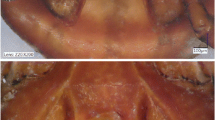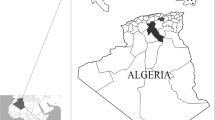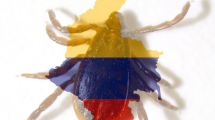Abstract
In this study the genetic variability of Rhipicephalus sanguineus within Brazil and its relation with ticks of the same group from different continents was evaluated. Mitochondrial 12S and 16S rDNA fragments of R. sanguineus from seven Brazilian States were sequenced and compared to GenBank sequences of R. sanguineus and R. turanicus ticks from Africa, Asia, Europe, South America and USA. Results indicate a relatively high intra-specific variability between Brazilian samples but also a global latitude linked distribution pattern of at least two major R. sanguineus groups; one group distributed from latitude 25°N to 22°S including R. sanguineus from Brazil, Taiwan and Thailand and R. turanicus from Zambia and Zimbabwe, and the other group found closer to the poles, roughly above 29°N and below 30°S with ticks from Argentina, Uruguay, France, Oklahoma (USA), Israel and Egypt.





Similar content being viewed by others
References
Aragão HB (1936) Ixodidas brasileiros e de alguns países limítrofes. Mem Inst Oswaldo Cruz 31(4):759–843
Beati L, Keirans JE (2001) Analysis of the systematic relationships among ticks of the genera Rhipicephalus and Boophilus (Acari: Ixodidae) based on mitochondrial 12S ribosomal DNA gene sequences and morphological characters. J Parasitol 87(1):32–48
Bernasconi MV, Casati S, Peter O, Piffaretti JC (2002) Rhipicephalus ticks infected with Rickettsia and Coxiella in Southern Switzerland (Canton Ticino). Infect Genet Evol 2:111–120
Black IV WC, Roehrdanz RL (1998) Mitochondrial gene order is not conserved in arthropods: prostriate and metastriate tick mitochondrial genomes. Mol Biol Evol 15(12):1772–1785
Black WC, Piesman J (1994) Phylogeny of hard- and soft-tick taxa (Acari: Ixodida) based on mitochondrial 16S rDNA sequences. Proc Natl Acad Sci USA 91:10034–10038
Demma LJ, Traeger MS, Nicholson WL et al (2005) Rocky mountain spotted fever from an unexpected tick vector in Arizona. New Engl J Med 353(6):587–594
Mangold AJ, Bargues MD, Mas-Coma S (1998) Mitocondrial 16S rDNA sequences and phylogenetic relationship of species of Rhipicephalus and other tick genera among Metastriata (Acari:Ixodidae). Parasitol Res 84:478–484
Moraes-Filho J, Pacheco R, Ogrzewalska M, Brandão P, Richtzenhain L, Labruna M (2008) Genetic analysis of different populations of Rhipicephalus sanguineus from South America, Mexico, Spain and South Africa: VI international conference on ticks and tick-borne pathogens (TTP-6). Buenos Aires, Argentina 21–26, 2008. Book of Proceedings, poster 272, p. 370
Murrell A, Campbell NJH, Barker SC (2000) Phylogenetic analyses of the rhipicephaline ticks indicate that the genus Rhipicephalus is paraphyletic. Mol Phylogenet Evol 16(1):1–7
Nava S, Guglielmone AA, Mangold AJ (2009) An overview of systematics and evolution of ticks. Front Biosci 14:2857–2877
Norris DE, Klompen JSH, Black WC (1999) Comparison of the mitochondrial 12S and 16S ribosomal DNA genes in resolving phylogenetic relationships among hard ticks (Acari : Ixodidae). Ann Entomol Soc Am 92(1):117–129
Oliveira PR, Bechara GH, Denardi SE et al (2005) Comparison of external morphology of Rhipicephalus sanguineus (Latreille, 1806) (Acari:Ixodidae) ticks from Brazil and Argentina. Vet Parasitol 129:139–147
Pegram RG, Clifford CM, Walker JB et al (1987a) Clarification of the Rhipicephalus sanguineus group (Acari: Ixodoidea: Ixodidae). I. R. sulcatus Neumann, 1908 and R. turanicus Pomerantsev, 1936. Syst Parasitol 10:3–26
Pegram RG, Keirans JE, Clifford CM et al (1987b) Clarification of the Rhipicephalus sanguineus group (Acari: Ixodoidea: Ixodidae). II. R. sanguineus (Latreille, 1806) and related species. Syst Parasitol 10:27–44
Rageau J (1953) Clés pour l′identification dês tiques du Cameroun. Ann Parasitol Hum Comp 28:5–6
Ribeiro AL, Faccini JLH, Daemon E (1996) Estudo das variações morfológicas de Rhipicephalus sanguineus (Latreille, 1806) (Acari:Ixodidae) no Brasi. Rev Univ Rural, Sér da Vida 18(1-2):25–33
Santos-Silva M, Beati L, Vilela C, Bacellar F (2008) Re-evaluation of the systematic status of Rhipicephalus sanguineus group in Portugal: VI international conference on ticks and tick-borne pathogens (TTP-6). Buenos Aires, Argentina 21-26, 2008. Book of Proceedings, poster 267, p. 365
Szabó MPJ, Mangold AJ, João CF et al (2005) Biological and DNA evidence of two dissimilar populations of the Rhipicephalus sanguineus tick group (Acari:Ixodidae) in South America. Vet Parasitol 130:131–140
Tamura K, Dudley J, Nei M et al (2007) MEGA4: molecular evolutionary genetics analysis (MEGA) software version 4.0. Mol Biol Evol. doi:10.1093/molbev/msm092
Walker JB, Keirans JE, Horak IG (2000) The genus Rhipicephalus (Acari:Ixodidae): a guide to the brown ticks of the world. Cambridge University Press, Cambridge
Acknowledgments
We would like to acknowledge Curso de Pós-Graduação em Ciências Veterinárias (CPGCV)/Coordenação de Aperfeiçoamento de Pessoal de Nível Superior (CAPES) and Fundação Carlos Chagas Filho de Amparo à Pesquisa do Estado do Rio de Janeiro (FAPERJ) for financial support, and Conselho Nacional de Desenvolvimento Científico e Tecnológico (CNPq) for scholarship (Leonardo Burlini). We are indebted to the researchers Alessandra Scofield Amaral, Carina Elisei, Fábio Barbieri, Isabela Martins, Lígia Borges, Renata Madureira and Silvia Maria Mendes Ahid for Rhipicephalus sanguineus samples. Part of this work has been facilitated through the International Consortium on Ticks and Tick-borne Diseases (ICTTD-3) Coordination Action financed by the INCO program of the European Commission Project No. 510561. We also would like to thank Anna Réz for reviewing English.
Author information
Authors and Affiliations
Corresponding author
Rights and permissions
About this article
Cite this article
Burlini, L., Teixeira, K.R.S., Szabó, M.P.J. et al. Molecular dissimilarities of Rhipicephalus sanguineus (Acari: Ixodidae) in Brazil and its relation with samples throughout the world: is there a geographical pattern?. Exp Appl Acarol 50, 361–374 (2010). https://doi.org/10.1007/s10493-009-9321-8
Received:
Accepted:
Published:
Issue Date:
DOI: https://doi.org/10.1007/s10493-009-9321-8




